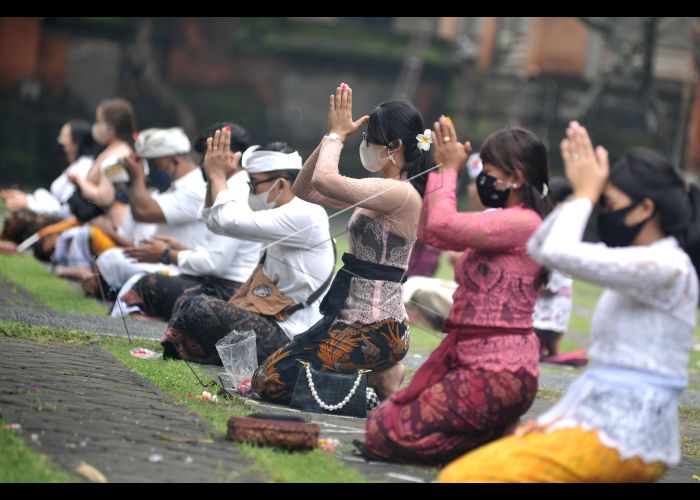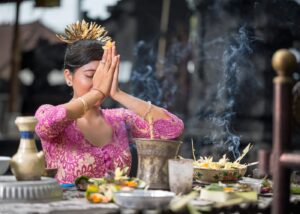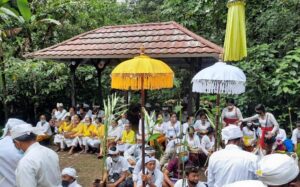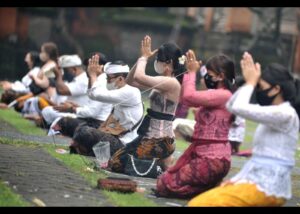Bali, an enchanting island in Indonesia, is famous not only for its natural beauty but also for its rich and captivating cultural heritage. One of its most striking aspects is the series of traditional Balinese ceremonies that celebrate daily life with stunning spiritual beauty. These ceremonies are not just magnificent dances and processions but also a profound reflection of the beliefs and religious values deeply rooted in Balinese society.
Each traditional ceremony holds a deep meaning, reinforcing the spiritual and social ties within the community. These rituals go beyond mere celebration; they are means of maintaining the balance of the universe, paying homage to ancestors, and celebrating life’s milestones, from birth to death. In this article, we’ll delve into a deeper understanding of the 8 amazing Traditional Balinese Ceremonies, focusing on their religious aspect. From celebrating the New Year to funerals, each ritual encapsulates a uniqueness and spiritual beauty that makes Bali a captivating place full of wonders.
8 Traditional Balinese Ceremonies
1.Nyepi
source : thehoneycombers.com
The first Traditional Balinese Ceremonies is Nyepi. Nyepi, also known as Saka New Year, is a crucial moment in Balinese culture. Preparations for Nyepi start with Melasti, where Balinese Hindus clean and purify statues and sacred objects in temples. This ritual is performed to spiritually cleanse before entering the new year. During Nyepi itself, Bali seems to ‘die’ for 24 hours, where there are no activities such as traveling, working, or even lighting fires. It’s a time for introspection, meditation, and self-purification.
Balinese people consider Nyepi a time to start the new year with a pure soul. What makes Nyepi unique is the entire community’s commitment to maintaining silence, which also reflects a deep spiritual belief. The silence of Nyepi offers an extraordinary experience for visitors, providing the opportunity to meditate and find peace in silence, quite different from the bustling daily life.
2.Galungan and Kuningan Ceremony
source : baligolive.com
Galungan and Kuningan are celebrations that mark the victory of Dharma over Adharma, a central concept in Hindu teachings. The highlight of this celebration is when penjors, typical decorative poles of Bali, are erected in front of each house. Penjors symbolize the victory of good and offer spiritual protection to the residents. During this celebration, the Balinese community also performs processions to temples, dances, and parades to express the joy of the triumph of good.
The day after, during Kuningan, the Balinese community goes to the temple to pray and offer offerings as a sign of respect for the ancestors. This ceremony is also a time to worship the god Wisnu, believed to descend to earth. Galungan and Kuningan are not just religious celebrations but also opportunities for the Balinese community to come together in joy.
3.Otonan Ceremony
source : nusantara7.id
Otonan is a very important annual celebration in Balinese culture. It is observed to commemorate an individual’s birthday according to the Balinese calendar. Otonan is conducted as a sign of respect and spiritual protection for the individual. The extended family gathers at the temple to pray together, honor the ancestors, and offer gratitude for the new year ahead. Otonan is observed with great attention as it’s considered to bring spiritual balance to daily life.
Each person has a different Otonan date according to the complex Balinese calendar, making it a very personal and sacred moment. Otonan is a ritual that teaches the importance of offerings and prayers to maintain spiritual harmony for the individual and their family. By providing detailed information with a descriptive touch, it can give a clearer idea of each Balinese traditional ceremony!
4.Ngaben Ceremony
source : bligojinkbali.com
Ngaben is a sacred funeral ceremony in Balinese culture. This procession aims to release the soul of the deceased from the attachments of the physical world and help it travel to the spiritual realm. This ritual involves the cremation of the body, believing it releases the soul of the deceased to continue its journey to the afterlife. During Ngaben, processions filled with symbolism take place, including the use of bamboo cannons, special dances, and offerings.
This ceremony is an important moment to honor the soul of the departed and offer them the opportunity to continue their journey to the next world. Ngaben is a mix of mourning for the departure of loved ones and acceptance of the ongoing cycle of life. It’s an effort to give a dignified tribute to the deceased while preparing for their spiritual journey after death. This ceremony shows the depth of spirituality and the strength of belief in celebrating life and embracing the passage of souls to the beyond.
5.Metatah Ceremony
source : aa.com.tr
Metatah is a ceremony that takes place when a child reaches adolescence, typically around the age of ten. This ceremony involves cutting the tips of the canines, symbolizing the release of negative traits. This process is also a symbol of the transition from childhood to adulthood and spiritual maturity. During this ceremony, the child undergoes a ritual of spiritual purification to start a new phase in their life. Metatah isn’t just a physical process of tooth cutting but also holds deep symbolic meaning in Balinese culture. This process is considered an essential step in the child’s spiritual journey to adulthood, preparing them to face life’s challenges with a more mature and wise soul. This ceremony also strengthens family and community ties, emphasizing the importance of traditional values and spirituality in daily life.
6.Mapag Toya Ceremony
Mapag Toya is an important ceremony in Balinese culture performed to purify water sources, such as springs or wells. Water is considered sacred in Balinese Hindu belief, and this ceremony aims to purify the water from negative energies and give it spiritual purity. The Mapag Toya ceremony involves prayers, special dances, and offerings to the God believed to control that water source. The belief in the importance of pure water makes this ceremony an integral part of maintaining the spiritual and physical safety of the Balinese community.
The Mapag Toya ceremony also reflects the harmonious relationship between humans and nature. Respecting the water source as a source of life is a strong representation of concern and gratitude for the environment. This procession functions not only as a religious ritual but also as a reminder of the importance of preserving the environment and the sustainability of essential natural resources for life.
7.Melasti Ceremony
source : radiomjnfm.blogspot.com
One of the highly anticipated moments in Bali is the Melasti ceremony. Conducted before the Nyepi celebration as part of the Saka New Year for the Balinese Hindu community, Melasti aims to purify the universe from any sin and impurity. Hindu followers gather at the seashore, dressed in their traditional attire while taking statues and sacred objects to the sea. This purification ritual is performed by sprinkling seawater on their sacred objects. This procession is enchanting, filled with sacred chants and dazzling religious dances, offering their purity to Sang Hyang Widhi.
8.Pagerwesi Ceremony
source : antarafoto.com
Pagerwesi is one of the traditional Balinese ceremonies celebrated to honor the purity of the soul. This ceremony aims to protect the soul from all forms of evil. On Pagerwesi day, Balinese Hindu followers gather at the temple to pay homage to Sang Hyang Widhi. They conduct the ceremony earnestly, using offerings of flowers, incense, and food as a sign of gratitude for the purity bestowed. Pagerwesi is a moment of reflection and soul purification, strengthening their spiritual ties.
Conclusion
Through this article, we’ve explored the spiritual beauty and religious values contained within the 8 amazing traditional Balinese ceremonies. From Nyepi, the guardian of silence for introspection, to Galungan celebrating the victory of good, each ceremony reflects the cultural richness and spiritual beliefs of the Balinese people. The traditional Balinese ceremonies are not just symbols of cultural identity but also open windows to the spiritual richness and local wisdom.
They provide a view into a world full of wonders, offering an inspiring perspective on diversity, spirituality, and living values in Balinese society. Join Salut Bali to explore the wonders of these rich in meaning traditional Balinese ceremonies. Experience and feel the spiritual beauty of Bali through Salut Bali’s eyes. Together, let’s understand the religious values embodied in each ritual, making this journey an enriching experience for the soul. Join the exploration of the uniqueness of Balinese traditional ceremonies with Salut Bali!












